tire type PONTIAC BONNEVILLE 1996 Owners Manual
[x] Cancel search | Manufacturer: PONTIAC, Model Year: 1996, Model line: BONNEVILLE, Model: PONTIAC BONNEVILLE 1996Pages: 387, PDF Size: 18.71 MB
Page 181 of 387
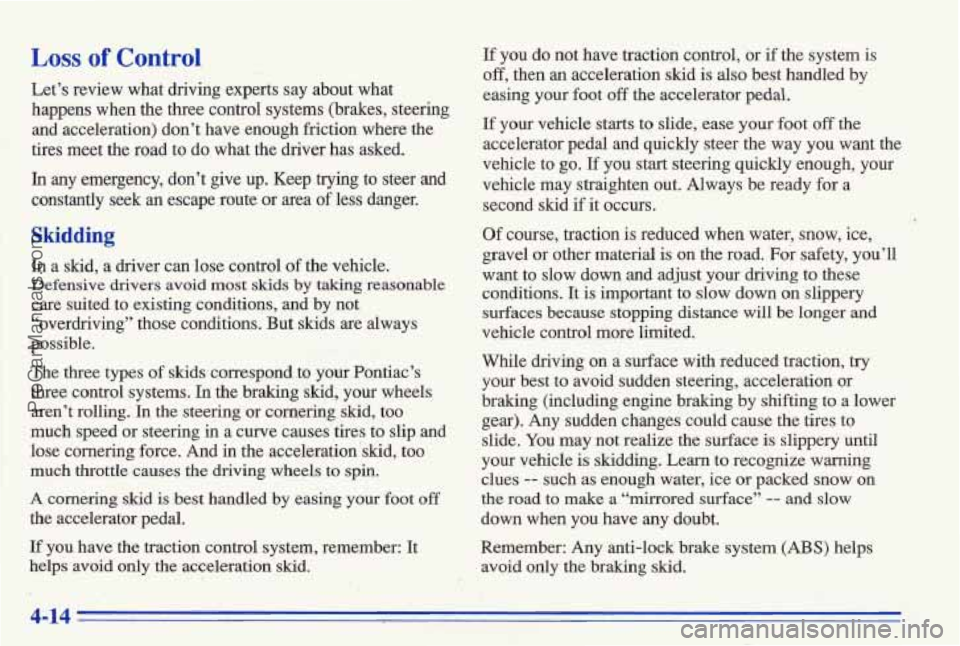
Loss of Control
Let’s review what driving experts say about what
happens when the three control systems (brakes, steering and acceleration) don’t have enough friction where the
tires
meet the road to do what the driver has asked.
In any emergency, don’t give up. Keep trying to steer and
constantly seek
an escape route or area of less danger.
Skidding
In a skid, a driver can lose control of the vehicle.
Defensive drivers avoid most skids by taking reasonable
care suited to existing conditions, and by not
“overdriving” those conditions. But skids
are always
possible.
The three types of skids correspond to your Pontiac’s
three control systems. In the braking skid, your wh’eels
aren’t rolling.
In the steering or cornering skid, too
much speed or steering in a curve causes tires to slip and lose cornering force. And
in the acceleration ‘skid, too
much throttIe causes the driving wheels
to spin.
A cornering skid is best handled by easing your foot off
the accelerator pedal.
If you have the traction control system, remember: It
helps avoid
only the acceleration skid.
If you do not have traction control, or if the system is
off, then an acceleration skid is also best handled by
easing your foot off the accelerator pedal.
If your vehicle starts to slide, ease your foot off the
accelerator pedal and quickly steer the way you want the
vehicle to
go. If you start steering quickly enough, your
vehicle may straighten out. Always be ready for a second skid if it occurs.
Of course, traction
i,s reduced when water, snow, ice,
gravel or other material
is on the road. For safety, you’ll
want to slow down and adjust your driving to these
conditions.
It is important to slow down on slippery
surfaces because stopping distance will
be longer and
vehicle control more limited.
While driving on a surface with reduced traction, try
your best to avoid sudden steering, acceleration or
braking (including engine braking by shifting to a lower
gear). Any sudden changes could cause the tires to
slide. You may not realize the surface
is slippery until
your vehicle is skidding. Learn to recognize warning
clues
-- such as enough water, ice or packed snow on
the road to make a “mirrored surface” -- and slow
down when you have any doubt.
Remember: Any anti-lock brake system
(ABS) helps
avoid only
the braking skid.
4-14
ProCarManuals.com
Page 234 of 387
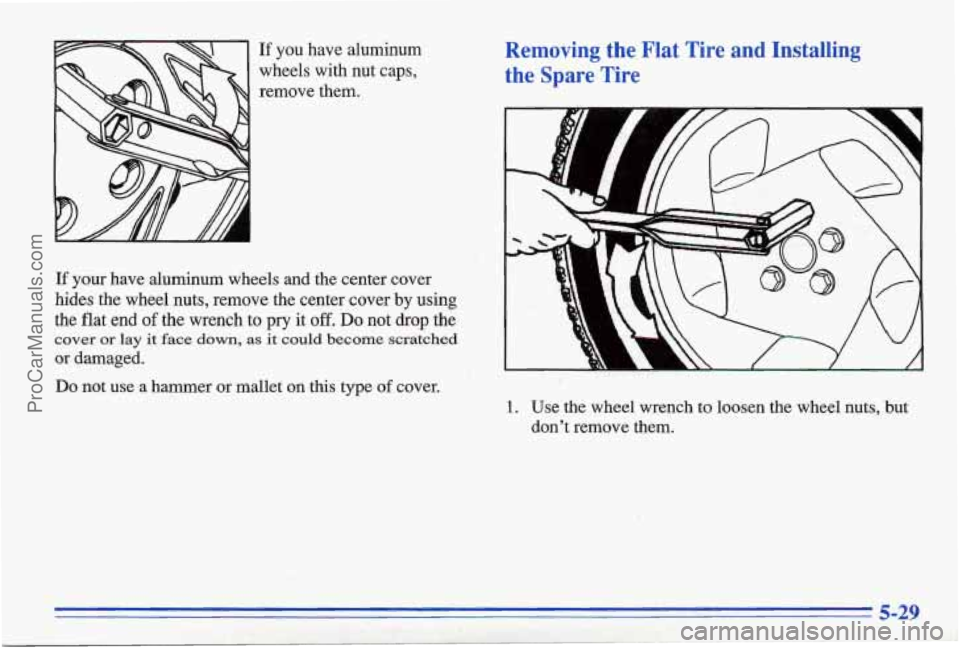
If you have aluminum
wheels with nut caps,
remove them., Removing the Flat Tire and Installing
the Spare Tire
If your have aluminum wheels and the center cover
hides the wheel nuts, remove the center cover
by using
the flat end of the wrench to pry it off. Do not drop the
cover or lay it face down, as it could become scratched
or damaged.
Do not use a hammer or mallet on this type of cover.
1. Use the wheel wrench to loosen the wheel nuts, but
don't remove them.
5-29
ProCarManuals.com
Page 286 of 387

Windshield Wiper Blade Replacement
Replacement blades come in different types and are
removed in different ways. Here’s how to remove the
type with a release clip:
1. Pull the windshield wiper arm away fiom the windshield.
2. Push down on the release clip with a screwdriver and
3. Push the new wiper blade securely on the wiper arm. ’
For the correct windshield wiper blade replacement length
and type, see “Capacities and Specifications’’ in the Index.
pull
the blade assembly
off the wiper arm.
Tires
We don’t make tires. Your new Pontiac comes with
high-quality
tires made by a leading tire manufacturer. If
you ever have questions about your tire warranty and
where to obtain service, see
your Pontiac Warranty
booklet
for details.
1 A CAUTION:
Poorly maintained and improperly used tires
are dangerous.
Overloading your tires can cause
overheating as a result
of too much friction.
You could have an air-out and a serious
accident. See “Loading Your Vehicle” in
the Index.
CAUTION: (Continued)
6-41
ProCarManuals.com
Page 288 of 387
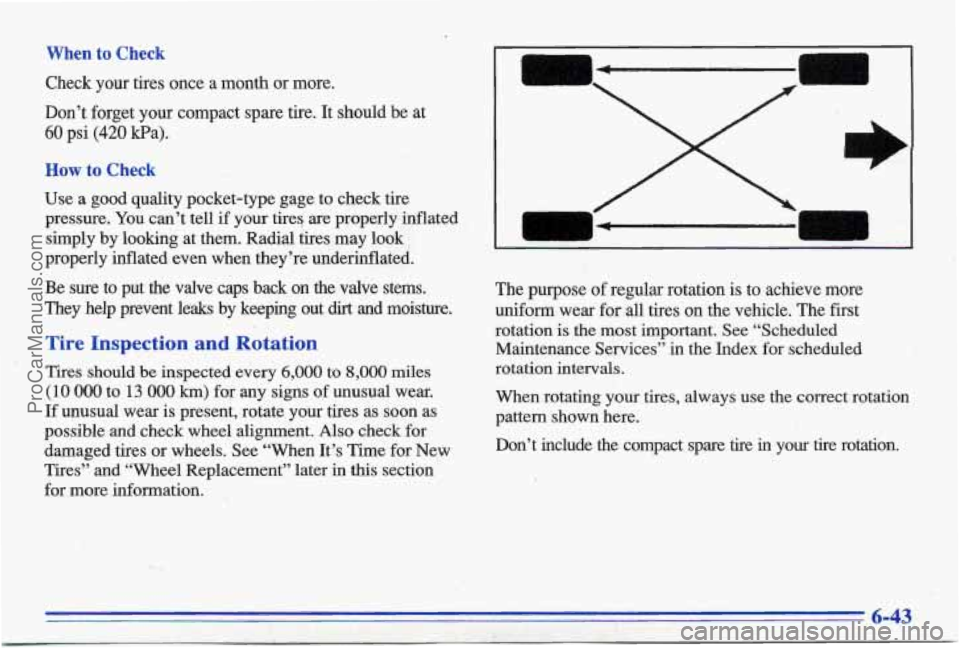
When to Check
Check your tires once a month or more.
Don’t forget your compact spare tire. It should be at
60 psi (420 kPa).
How to Check
Use a good quality pocket-type gage to check tire
pressure. You can’t tell
if your tires are properly inflated
simply by looking at them. Radial tires may look
~
properly inflated even when they’re underinflated.
Be sure to put the valve caps back on the valve stems.
They help prevent l&s by keeping out
dirt and moisture.
Tire Inspection and Rotation
Tires should be inspected every 6,000 to 8,000 miles
(10 000 to 13 000 km) for any signs of unusual wear.
If unusual -wear
is present, rotate your tires as soon as
possible and check wheel alignment.
Also check for
damaged tires or wheels. See “When It’s Time for Ne,w
Tires” and “Wheel Replacement” later in
this section
for more information. The purpose
of regular rotation is to achieve more
uniform wear for all tires
on the vehicle. The first
rotation is the most
important. See “Scheduled
Maintenance Services”
in the Index for scheduled
rotation
intervals.
When rotating your tires, always use the correct rotation
pattern shown here.
Don’t include the compact spare tire
in your tire rotation.
,. .
ProCarManuals.com
Page 290 of 387
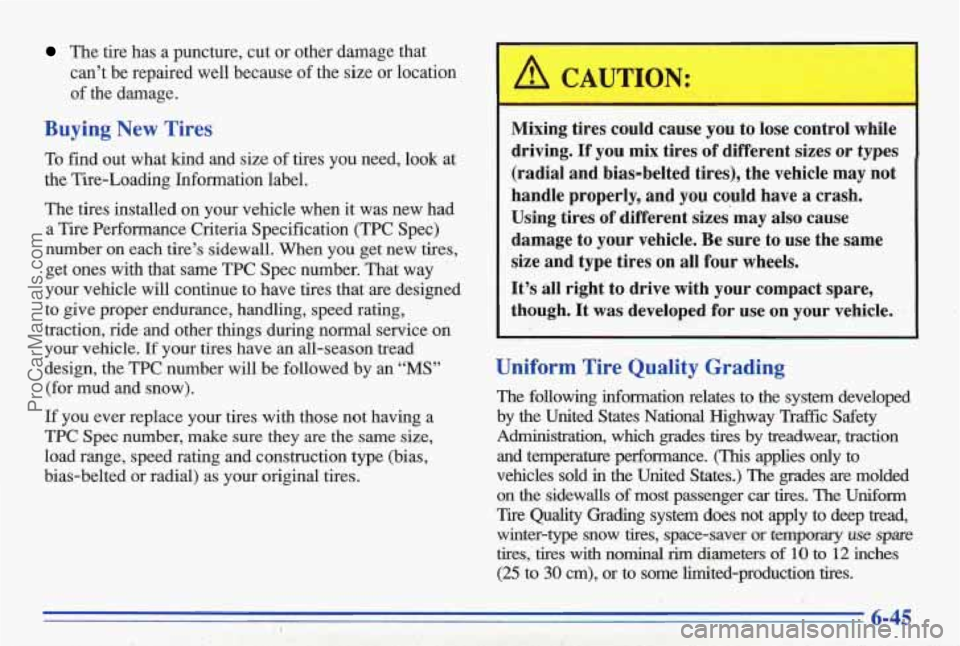
The tire has a puncture, cut or other damage that
can’t be repaired well because of the size or location
of the damage.
Buying New Tires
To find out what kind and size of tires you need, look at
the Tire-Loading Information label.
The tires installed on your vehicle when it was new had
a Tire Performance Criteria Specification (TPC Spec)
number on
each tire’s sidewall. When you get new tires,
get ones with that same TPC Spec number. That way
your vehicle will continue to have tires that are designed
to give proper endurance, handling, speed rating,
traction, ride and other things during normal service
on
your vehicle. If your tires have an all-season tread
design, the TPC number will be followed by an
“MS”
(for mud and snow).
If you ever replace your tires with those not having a
TPC Spec number, make sure they are the same size,
load range, speed rating and construction type (bias,
bias-belted or radial) as your original tires.
A CAUTION:
Mixing tires could cause you to lose control while
driving.
If you mix tires of different sizes or types
(radial and bias-belted tires), the vehicle may not
handle properly, and you could have a crash.
Using tires
of different sizes may also cause
damage to your vehicle. Be sure to use the same
size and type tires on
all four wheels.
It’s all right to drive with your compact spare,
though. It was developed
for use on your vehicle.
Uniform Tire Quality Grading
The following information relates to the system developed
by the United States National Highway Traffic Safety
Administration, which grades tires by treadwear, traction and temperature performance.
(Th.zs applies only to
vehicles sold in the United States.) The grades are molded
on the sidewalls of most passenger car tires. The Uniform
Tire Quality Grading system does not apply to deep tread, winter-type snow tires, space-saver
or temporary use spare
tires, tires with nominal rim diameters of 10 to 12 inches
(25 to 30 cm), or to some limited-production tires.
I 6-45
ProCarManuals.com
Page 293 of 387

NOTICE:
The wrong wheel can also cause problems with
bearing life, brake cooling, speedometer/odometer
calibration, headlamp aim, bumper height, vehicle
ground clearance and tire or tire chain clearance to
the body and chassis.
.. -* ‘ .. ’ see “Changing a Flat Tire” in the Index for
‘more information.
.. .‘I, . .I .
.‘. -- . 8; . Putting a used wheel on your vehicle is
;. .. . dangerous. You can’t know how it’s been used or
,.; how many miles it’s been driven. It could fail
-. :% suddenly and cause an accident. If you have to
. -1 . .. I -.~ I., .<.
.. ?1 :: :. <.. >. - ., 3
I .) .
,,.. ‘,,‘t, . .?. I
.: replace a wheel, use a new GM original
.I , . ..
., , equipment wheel. -.
-. ., ..
I
Tire Chains
NOTICE:
Use tire chains only where legal and only when
you must. Use only
SAE Class 44S” type chains
that are the proper size for
your tires. Install
them on the front tires and tighten them as
tightly as possible with the ends securely
fastened. Drive slowly and follow the chain
manufacturer’s instructions.
If you can hear the
chains contacting
your vehicle, stop and retighten
them.
If the contact continues, slow down until it
stops. Driving too fast or spinning the wheels
with chains on will damage your vehicle.
* “
ProCarManuals.com
Page 294 of 387

Appearance Care Don't use any of these unless this manual says you can.
In many uses, these will damage your vehicle:
Remember, cleaning products can be hazardous. Some
are toxic. Others can burst into flame
if you strike a Alcohol
match
or get them on a hot part of the vehicle. Some are 0 Laundry Soap
dangerous
if you breathe their fumes in a closed space.
When you use anything from a container
to clean your
Pontiac, be sure to follow the manufacturer's warnings
Reducing Agents
Bleach
and instructions. And always open your doors or
windows when you're cleaning the inside.
~: y -.% :'; - : Cleaning the Inside of Your Pontiac
Never use these to clean your vehicle:
Gasoline
Benzene
Naphtha
Carbon Tetrachloride
Acetone
PaintThinner
0 Turpentine
Lacquer Thinner
Nail Polish Remover
They can all be hazardous
T- some more than
others
-- and they can all damage your vehicle, too.
1.. . >, .. . ~.. ..&. - . .: .. .'#'.-: Use a vacuum cleaner often to get rid of dust and loose .f, r :'.;.,.,-
.I .. .., , ..; .. \..: ,.. i$,;--;;l .*. dirt. Wipe vinyl or leather with a clean, damp cloth ..
Your Pontiac dealer has two GM cleaners, a
solvent-type spot lifter and a foam-type powdered
cleaner. They will clean normal spots and stains very
well. Do not use them on vinyl or leather.
Here are some cleaning tips:
Always read the instructions on the cleaner label.
' Clean up stains as soon as you can -- before they set.
0 Use a clean cloth or sponge, and change to a clean area
Use solvent-type cleaners in a well-ventilated area
0 If a ring forms after spbt cleaning, clean the entire
often..
A
soft brush may be used if stains are stubborn.
only.
If you use them, don't saturate the stained ma.
ProCarManuals.com
Page 310 of 387
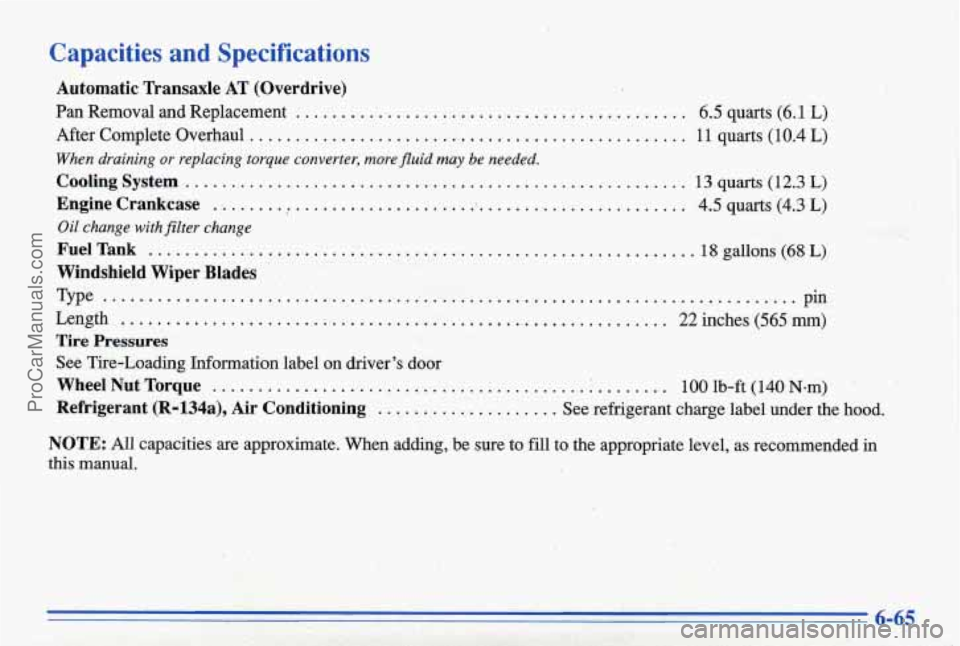
Capacities and Specifications
Automatic Transaxle AT (Overdrive)
Pan Removal and Replacement .... '. ......................................
After Complete Overhaul ................................................
When draining or replacing torque converter, more fluid may be needed.
CoolingSystem .......................................................
Enginecrankcase .....................................................
Oil change with filter change
FuelTank .........................................
Windshield Wiper Blades
Type ..............................................
..
..
...
...
6.5 quarts (6.1 L)
11 quarts (10.4 L)
13 quarts (12.3 L)
4.5 quarts (4.3 L)
..
..
............ 18 gallons (68 L)
....................... Pin
Length
............................................................ 22 inches (565 mm)
Tire Pressures
See Tire-Loading Information label on driver's door
WheelNutTorque ......................................... ;........ lOOlb-ft(140N~m)
Refrigerant (R=l34a), Air Conditioning .................... See refrigerant charge label under the hood.
ProCarManuals.com